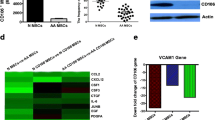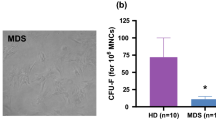Abstract
Objective
The aim of the study was to investigate the expression pattern of hematopoietic transcription factor GATA-1, -2 and -3 genes in leukemic bone marrow (BM) microenvironment [including bone marrow stromal cells (BMSCs) and BM hematopoietic cells].
Methods
Mononuclear cells were isolated from BM of patients with acute myeloid leukemia (AML), chronic myelogenous leukemia (CML), or acute lymphoblastic leukemia (ALL). Adherent cells (BMSCs) and nonadherent cells (BM hematopoietic cells) were collected after long-term culture in vitro. The semi-quantitative expression levels of GATA genes in the BMSCs or BM hematopoietic cells from patients with leukemia were analyzed by using RT-PCR-ELISA and compared with normal controls.
Results
The expression level of GATA-1 gene in the BMSCs from CML group was significantly lower than that of the normal controls. The expression level of GATA-3 gene in the BMSCs from ALL was higher than that of the normal controls, but that from CML was lower than the normal controls. Dominant expression of GATA-3 gene was found in the normal BM hematopoietic cells. The dominant expression of GATA-2 gene was found in the normal BMSCs and the BMSCs from CML, whereas the dominant expression of GATA-3 gene was detected in the BMSCs from AML.
Conclusion
GATA-1, -2 and -3 genes might play a role in hematopoiesis regulation in leukemia, and the changes of expression pattern of GATA genes might influence the hematopoiesis in BM microenvironment and relate to the pathogenesis and development of leukemia.
Similar content being viewed by others
References
Ghatpande S, Ghatpande A, Sher J, et al. Retinoid signaling regulates primitive (yolk sac) hematopoiesis. Blood, 2002, 99: 2379–2386.
Li YQ, Yang LJ, Chen SH. Expression and mutation analysis of transcription factor GATA-3 gene in chronic myeloid leukemia. J Exp Hematol (Chinese), 1999, 7: 265–268.
Li YQ, Yang LJ, Chen SH, et al. The insertional mutation of transcription factor GATA-2 gene in acute non-lymphocytic leukemia. J Exp Hematol (Chinese), 2000, 8: 255–260.
Shimizu R, Trainor CD, Nishikawa K, et al. GATA-1 self-association controls erythroid development in vivo. J Biol Chem, 2007, 282: 15862–15871.
Dao MA, Nolta JA. Cytokine and integrin stimulation synergize to promote higher levels of GATA-2, c-myb, and CD34 protein in primary human hematopoietic progenitors from bone marrow. Blood, 2007, 109: 2373–2379.
Yang Z, Jiang H, Zhao F, et al. A highly conserved regulatory element controls hematopoietic expression of GATA-2 in zebrafish. BMC Dev Biol, 2007, 7: 97.
Kim PJ, Pai SY, Brigl M, et al. GATA-3 regulates the development and function of invariant NKT cells. J Immunol, 2006, 177: 6650–6659.
Usui T, Preiss JC, Kanno Y, et al. T-bet regulates Th1 responses through essential effects on GATA-3 function rather than on IFNG gene acetylation and transcription. J Exp Med, 2006, 203: 755–766.
Wu X, Li Y, Zhu K, et al. GATA-1, -2 and -3 genes expression in bone marrow microenviroment with chronic aplastic anemia. Hematology, 2007, 12: 331–335.
Li Y, Yang L, Chen S, et al. Clonal expansion T cells identified in acute monoblastic leukemia by CDR3 size analysis of TCR V beta repertoire using RT-PCR and genescan. Chin Med J (Engl), 2002, 115: 69–71.
Hossain MB, Hosokawa H, Hasegawa A, et al. Lymphoid enhancer factor interacts with GATA-3 and controls its function in T helper type 2 cells. Immunology, 2008, 125: 377–386.
Ho IC, Pai SY. GATA-3 — not just for Th2 cells anymore. Cell Mol Immunol, 2007, 4: 15–29.
Tan AH, Goh SY, Wong SC, et al. T helper cell-specific regulation of inducible costimulator expression via distinct mechanisms mediated by T-bet and GATA-3. J Biol Chem, 2008, 283: 128–136.
Matsuo Y, Drexler HG, Harashima A, et al. Transcription factor expression in cell lines derived from natural killer-cell and natural killerlike T-cell leukemia-lymphoma. Hum Cell, 2004, 17: 85–92.
Tsuzuki S, Enver T. Interactions of GATA-2 with the promyelocytic leukemia zinc finger (PLZF) protein, its homologue FAZF, and the t(11;17)-generated PLZF-retinoic acid receptor alpha oncoprotein. Blood, 2002, 99: 3404–3410.
Fukuchi Y, Yamato K, Kawamura C, et al. p27KIP1 and GATA-1 are potential downstream molecules in activin A-induced differentiation and apoptosis pathways in CML cells. Oncol Rep, 2006, 16: 1099–1103.
Zhang SJ, Ma LY, Huang QH, et al. Gain-of-function mutation of GATA-2 in acute myeloid transformation of chronic myeloid leukemia. Proc Natl Acad Sci USA, 2008, 105: 2076–2081.
Author information
Authors and Affiliations
Corresponding author
Additional information
Supported by a grant from National Scaling Height Program, China (No. 95-zhuan-10).
Rights and permissions
About this article
Cite this article
Wu, X., Li, Y., Zhu, K. et al. Expression pattern of GATA-1, -2 and -3 genes in leukemic bone marrow microenvironment. Chin. -Ger. J. Clin. Oncol. 8, 541–545 (2009). https://doi.org/10.1007/s10330-009-0101-z
Received:
Revised:
Accepted:
Published:
Issue Date:
DOI: https://doi.org/10.1007/s10330-009-0101-z




